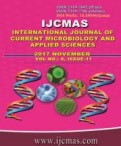


 National Academy of Agricultural Sciences (NAAS)
National Academy of Agricultural Sciences (NAAS)

|
PRINT ISSN : 2319-7692
Online ISSN : 2319-7706 Issues : 12 per year Publisher : Excellent Publishers Email : editorijcmas@gmail.com / submit@ijcmas.com Editor-in-chief: Dr.M.Prakash Index Copernicus ICV 2018: 95.39 NAAS RATING 2020: 5.38 |
Genome editing is a technique in which changes are made in the DNA of any organism. A nuclease promotes breaks in the DNA at a specific sequence which is repaired by several mechanisms. It is one of the efficient technologies which enable us to change and edit genome of any organism precisely and accurately. Multiple genome editing technologies have been employed, including zinc finger nucleases, mega nucleases, clustered regularly interspaced short palindromic repeats (CRISPR) along with Cas9 protein and transcription activator-like effector nucleases to modify genome of an organism. These genome editing technologies exercise several repair systems in which through the applying site-specific nucleases, areas are altered. SSNs induce double-strand breaks (DSBs) at predetermined locus in the targeted genome, which can be repaired utilizing well-known procedures such as non-homologous end-joining or homology-directed repair. Genome editing technique is reliable for enhancing average yield to fulfil the booming demands of the world’s current food shortage and to establish a viable and ecologically safe agriculture scheme, to more precise, productive, economical and eco-friendly.
 |
 |
 |
 |
 |